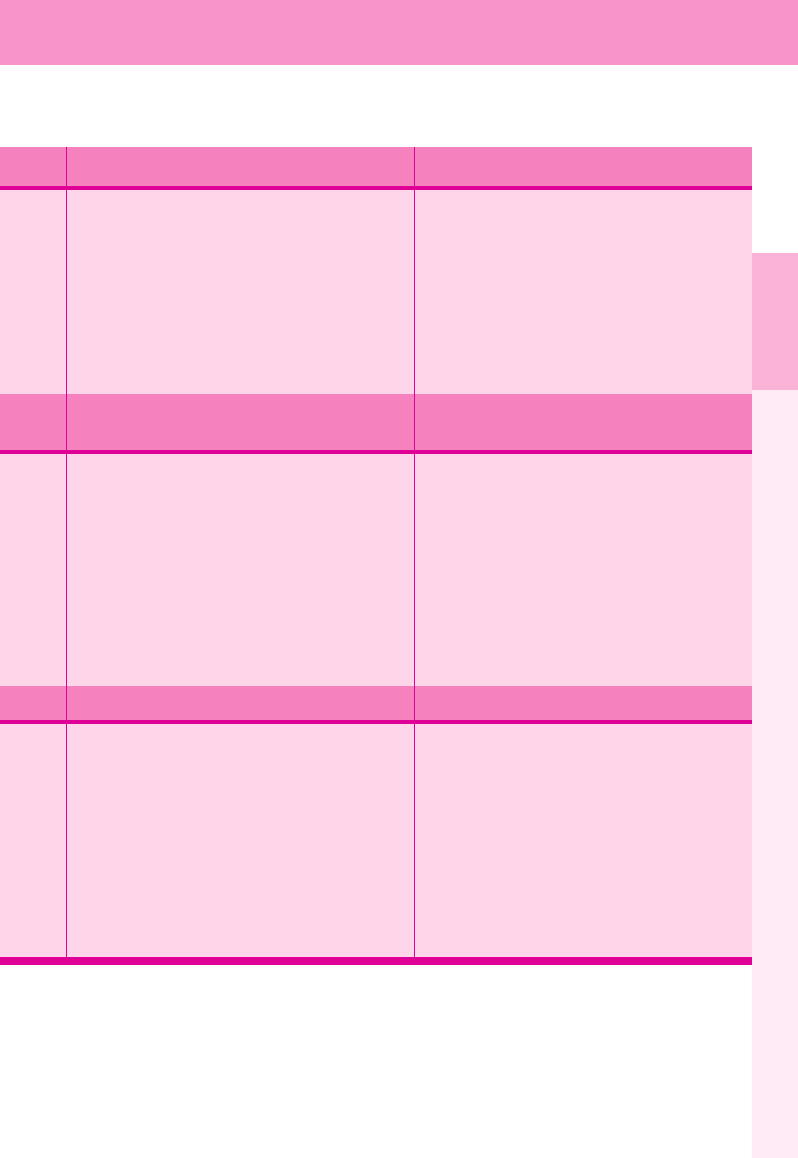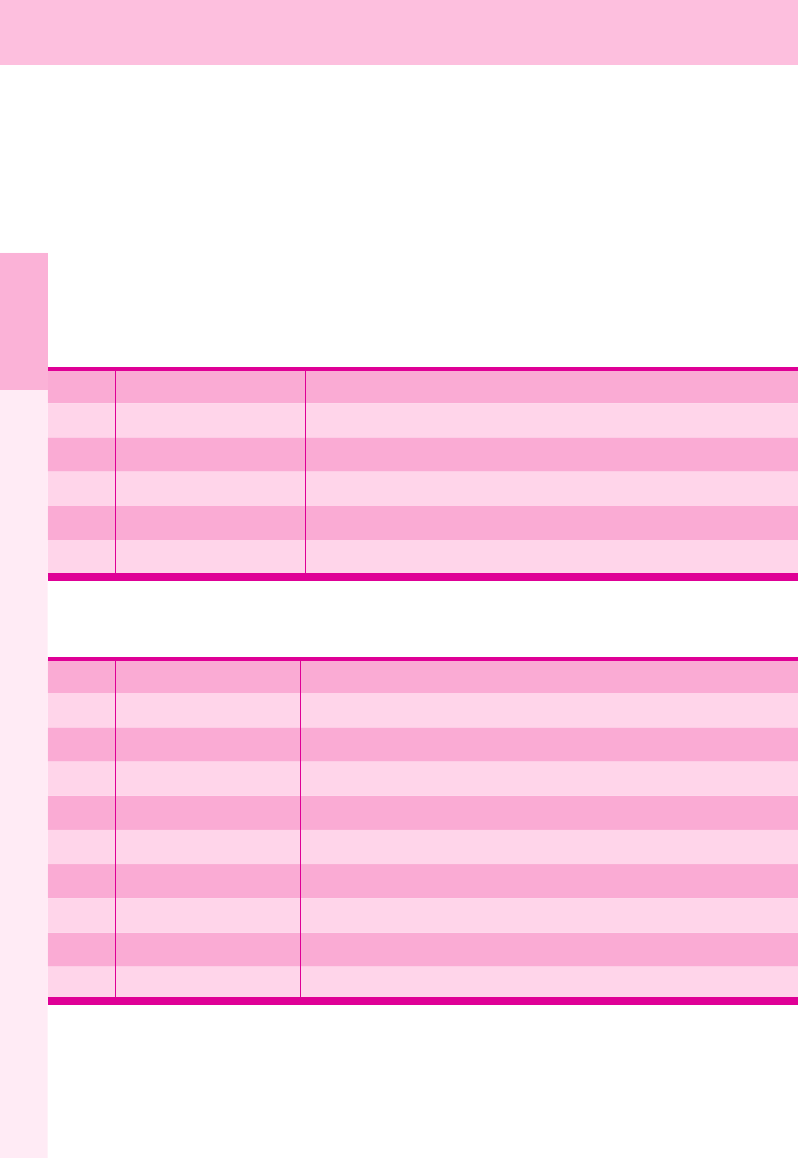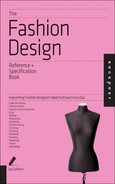
Job:12-29742 Title:RP-Fashion Design Ref and Spec Book
#175 Dtp:204 Page:66
064-071_30034.indd 66 2/27/13 4:13 PM
6 6 THE FASHION DESIGN REFERENCE + SPECIFICATION BOOK
(Text)
Chapter 5: Crafting Questions
Among the rst questions a designer might ask is Why ask questions? The an-
swer goes to the heart of design, because good design speaks to ideas potent
with meaningful content. Crafting good questions can precipitate a windfall of
information and ideas. When questions hit the mark, they yield more re ned
questions that reach into the core of an idea. This path of inquiry helps to
extend a concept as far and as wide as it can go.
Asking questions, well-crafted or otherwise, is an exercise requiring active
engagement. Designers invite others to share their perspectives and prefer-
ences. Listening quietly, with earnest curiosity, and leaving personal opinion
out of the mix are prerequisites. Designers will have plenty of time to interpret
and make a mark on the information once they have collected it and applied it
to their fashion goal.
SOCRATIC METHOD
The Socratic style of questioning calls for the responses to be accurate and for the thought
process behind them to be complete. It offers the fashion designer a good model with which
to begin. If the answers meet the challenge of this type of inquiry, they move the dialogue
in the direction of actions that will benefit the designer’s goal. Open-ended questions elicit
detailed responses. They also generate subtle insights beyond the basic information being
addressed. This technique is especially good for project development because it provides
in-depth understanding. Designers can present their questions about a design concept,
collection, or line they have created. The questions can be self-imposed or directed toward
a design team.
Q
H
W
H
W
Q
W
W
p
H
d
W
Q
I
W
e
H
W
p
05
Job:12-29742 Title:RP-Fashion Design Ref and Spec Book
#175 Dtp:204 Page:66
064-071_30034.indd 66 2/27/13 4:12 PM

Job:12-29742 Title:RP-Fashion Design Ref and Spec Book
#175 Dtp:204 Page:67
Book
ge:66
064-071_30034.indd 67 2/27/13 4:13 PM
67
(Text)
Questions that Clarify Questions that Challenge Perspectives
How much more can you tell me?
Why is this the right direction at this time?
How does this idea relate to the company brand?
What do you already know about your audience?
Why is one viewpoint more valid than another?
Why have others been successful with similar and
dissimilar products?
How would your customers respond to this collection
and how would they bene t?
What are the strengths and weaknesses of this plan?
Questions that Probe Assumptions Questions that Investigate Implications
and Consequences
What are you taking for granted?
Why would you assume a customer would buy your
product versus a competitor’s?
How can you verify or prove that there is a need or
desire for this style?
What would happen if the market changed dramatically?
Is the projection or forecast valid?
Why will this be your best work to date?
How does this collection affect the development of
your brand?
What happens once you are in the marketplace?
Questions that Scrutinize Reasoning Questions that Examine the Question
Is the evidence there?
Why is this trend happening now and are those reasons
enough to make you follow?
How can you be sure that your resources are accurate?
What evidence do you have to back up your proposed
project?
Why ask why?
Why bother to explore the idea for this project?
How does this concept apply to everyday life?
What was the point of all the research?
05
Job:12-29742 Title:RP-Fashion Design Ref and Spec Book
#175 Dtp:204 Page:67
Book
ge:66
064-071_30034.indd 67 2/27/13 4:12 PM

Job:12-29742 Title:RP-Fashion Design Ref and Spec Book
#175 Dtp:204 Page:68
064-071_30034.indd 68 2/27/13 4:13 PM
6 8 THE FASHION DESIGN REFERENCE + SPECIFICATION BOOK
(Text)
OTHER MODELS
Fashion designers, like other creative people, have many different models for asking
questions, depending on the particular subject of their investigation. They must then
discern which body of answers is applicable and analyze their meanings to evaluate
how to best use the information. The models on these pages are useful, respectively,
when establishing the basics associated with an idea; when building a well-structured,
engaging story around a brand; when building a talent and resource inventory of the
designer’s team and associates; and when exploring the big picture.
STORYTELLING LITERATURE: Designing a Collection or Portfolio
Cover
What would establish the appropriate first impression?
Jacket Flaps
How would you pique the interest of your audience?
Contents
What would be the structure of your story or project?
Introduction
How would you set the tone with meaning?
Forward
Who would be a spokesperson to endorse your product or service?
Act 1
Beginning: How would the beginning capture an audience’s imagination?
Act 2
Middle: What struggles could you anticipate and how would you resolve them?
Act 3
End: What would success look like in the end?
Summary
How do you reinforce the connection with your audience?
Bibliography
What information could you freely share that would add value?
THE FACTS JOURNALISM: Target Market
Who?
Who is your audience?
What?
What are their needs?
Where?
Where are they located?
Why?
Why would they choose your product or service over another?
When?
When will you be engaging your target audience?
How?
How will you deliver your idea?
I
H
05
Job:12-29742 Title:RP-Fashion Design Ref and Spec Book
#175 Dtp:204 Page:68
064-071_30034.indd 68 2/27/13 4:12 PM

Book
ge:68
Job:12-29742 Title:RP-Fashion Design Ref and Spec Book
#175 Dtp:204 Page:69
064-071_30034.indd 69 2/27/13 4:13 PM
Crafting Questions 6 9
(Text)
IN DEPTH BUSINESS PLAN: Producing/Marketing a Line
Executive Summary
How would you sum up the best in all areas of your proposal?
History
What is the history of your products/services and what, if any, part have you played?
Objectives
What needs or desires do you fill for your customer?
Products/Services
What will your menu of products/services comprise?
Persuasive Statement
Why would someone be a fan of your work?
Projected Growth
What is your plan for creating and expanding value?
History of Key Team
What are the backgrounds of everyone involved?
Management Team
Who will run things the way that you would?
Funding Requirements
What is the cost for what you need to put in place (staff, equipment, materials)?
Timeline
What is the rollout schedule for your product?
Target Market
Where will you implement the plan?
Marketing Plan
How will you position your brand in the marketplace?
The Competition
Who is doing what you are doing and how are they doing it?
Operations
How will things be carried out?
Personnel
Who will execute your ideas?
Manufacturing
Who will make the product?
HUMAN RESOURCES THE RÉSUMÉ: Employment/Job Search
Cover Letter
How do you introduce yourself to the industry?
Objective
What will be your contribution to the marketplace?
Experience
What do you (and your team) bring to the table?
Education
What have you learned? Where did you learn it? How does that factor in?
References
Who can and will speak on your behalf?
Special Skills
Which related and unrelated skills add value to your enterprise?
Interests
What unique interests color your approach?
Affiliations
What organizations would make good partners?
Contacts
What are the best methods of contacting your peers, staff, and/or customers?
05
Book
ge:68
Job:12-29742 Title:RP-Fashion Design Ref and Spec Book
#175 Dtp:204 Page:69
064-071_30034.indd 69 2/27/13 4:12 PM

Job:12-29742 Title:RP-Fashion Design Ref and Spec Book
#175 Dtp:204 Page:70
064-071_30034.indd 70 2/27/13 4:13 PM
70 THE FASHION DESIGN REFERENCE + SPECIFICATION BOOK
(Text)
BIG QUESTIONS
Art versus Design
What is the difference between art and design? Art answers a self-imposed challenge. Design,
on the other hand, must respond to the demands of the consumer. Fashion can indeed rise
to the level of art in the hands of a designer who has the vision and the ability to realize the
potential of an idea. But the most important thing for designers to consider when wrestling
with the kind of approach they want to apply is balance. Is it enough for the arc of a designer’s
career to serve a need for notoriety or financial reward? What will a designer’s legacy be?
Heady questions, but the answers will provide designers with a metric with which to measure
their success.
The Business of Fashion
Anyone looking to make a living from a career in fashion must contend with the business of
fashion. Often creative types will feel at odds with the operational demands of the commercial
side of what they do. Business practices will be described as dry, boring, or tedious. How does
a designer dispel preconceived notions about day-to-day operations?
Fashion designers are in the unique position of being creative problem solvers. Hence the
challenge moves beyond how to get the job done, to how to get the job done in an imaginative
way. Some chores can’t be reinvented, but they can be seen as a part of something more re-
warding. In this instance, the important question is, How can you look at a task differently?
Boundaries
When limits constrain designers’ creative flow, they must ask how they can redefine the situa-
tion. These limits may present themselves in the form of very tangible points such as budget.
In times of financial hardship, for example, where will the cuts be made? Quality? Quantity?
Ornamentation? Advertising? Each area of the designer’s enterprise needs to be scrutinized
with questions that address how integrity survives these realities.
More subjective boundaries may be placed on what designers will produce if they feel the
need to respect or rebel against the current restrictions of society and the market. How does
censorship become inspiration? The director Alfred Hitchcock was well known for skirting Hol-
lywood’s Hay Production Code, which from 1930 to 1968 imposed censorship guidelines on
moviemakers. The result was more often than not groundbreaking. The code stipulated that an
on-screen kiss could not last longer than three seconds. Hitchcock created memorable screen
kisses in Notorious (1946) and To Catch a Thief (1955) by using a very clever cutting style.
Technically, each segment of the kiss clocked in at three seconds. In Notorious the kiss was
intercut with conversation and in To Catch a Thief with images of fireworks bursting in air. In
t
h
Fa
tu
b
ge
m
H
T
O
if
se
id
th
s
to
a
b
T
fa
lit
p
s
m
co
T
of
th
th
af
e
C
n
u
k
m
fo
o
05
Job:12-29742 Title:RP-Fashion Design Ref and Spec Book
#175 Dtp:204 Page:70
064-071_30034.indd 70 2/27/13 4:12 PM
..................Content has been hidden....................
You can't read the all page of ebook, please click here login for view all page.
